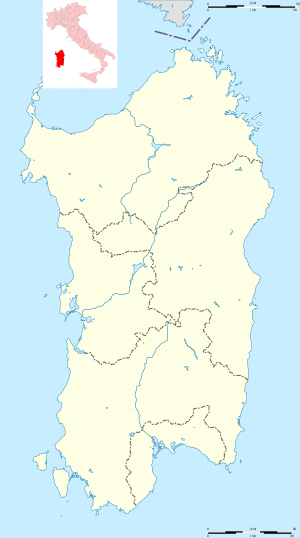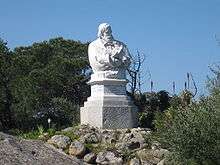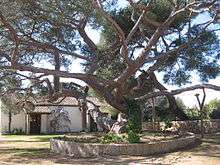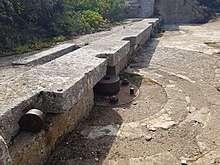Caprera
|
Cala Napoletana on the northwest shore of Caprera | |
 Caprera | |
| Geography | |
|---|---|
| Location | Strait of Bonifacio |
| Coordinates | - 41°12′26″N 9°27′40″E / 41.207222°N 9.461111°ECoordinates: 41°12′26″N 9°27′40″E / 41.207222°N 9.461111°E |
| Archipelago | Maddalena archipelago |
| Area | 15.7 km2 (6.1 sq mi) |
| Highest elevation | 212 m (696 ft) |
| Highest point | Monte Tejalone |
| Administration | |
|
Italy | |
| Region | Sardinia |
| Province | Olbia-Tempio |
Caprera is an island in the Maddalena archipelago off the coast of Sardinia, Italy.[1] In the area of La Maddalena island in the Strait of Bonifacio, it is a tourist destination and the place to which Giuseppe Garibaldi retired from 1854 until his death in 1882.[1]
Features
The island was probably given its name because of the numerous wild goats living on it (capra means "goat" in Italian). It is the second largest island in the archipelago and has an area of 15.7 km2 (6.1 sq mi) and 45 km (28 mi) of coastline. Monte Tejalone is the highest point (212 m). On the south-western side is a sailing centre and the many coves and anchorages along the coastline make the landing easy. This island has been declared a natural reserve for the resident seabirds, the royal seagull, cormorant and peregrine falcon. Caprera is linked to La Maddalena island by a 600-metre (2,000 ft) causeway.
Giuseppe Garibaldi


The island is associated with Giuseppe Garibaldi, an Italian patriot and fighter who lived in the 19th century and was one of the fathers of Italian unification. He bought about half of the island in 1855 and died there in 1882. His house is now a museum and a memorial chapel, and the island is a national monument.
History

After the Roman occupation, Caprera remained deserted for centuries before being inhabited by groups of shepherds. Many remains of Roman cargo ships were found there. In 1855 Garibaldi decided to settle there and planted the first trees of the blooming pinewood which covers the island today. A century after Garibaldi's death, the island was freed from military restrictions and is completely open to the public.
Sailing
Caprera's Porto Palma gulf is home to the Centro Velico Caprera school since 1967.
See also
References
- 1 2

External links
- Sito web istituzionale del Parco Nazionale dell'Arcipelago La Maddalena
- Mio Padre, ricordi di Clelia Garibaldi
| Wikimedia Commons has media related to Caprera. |